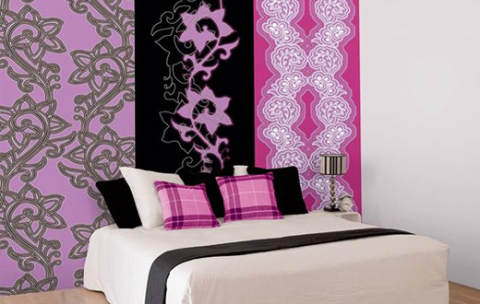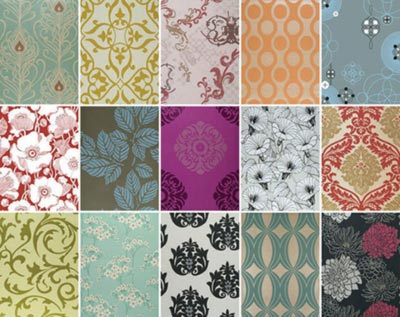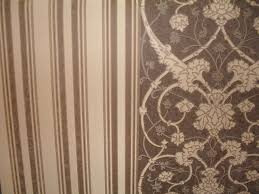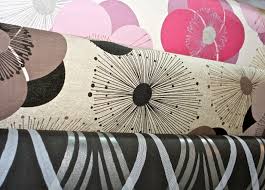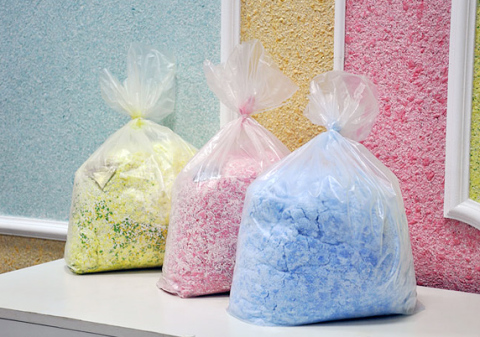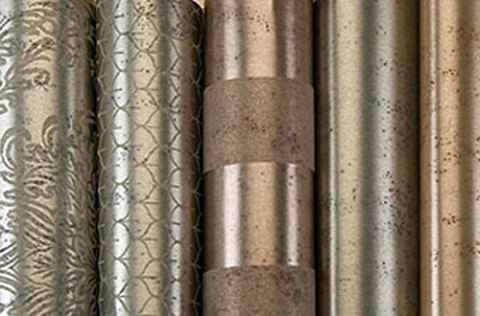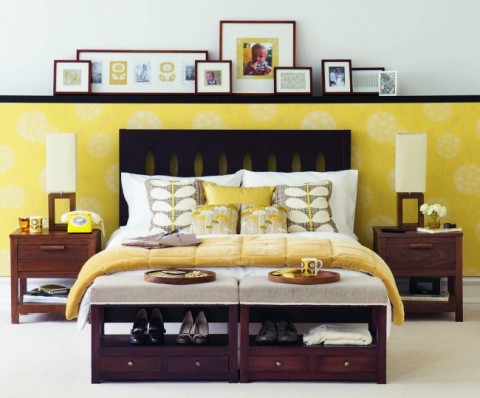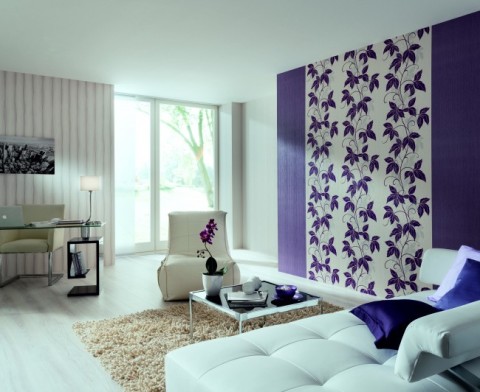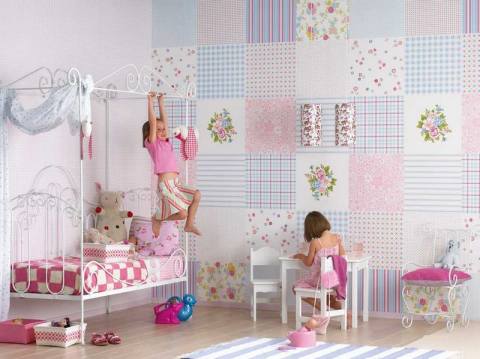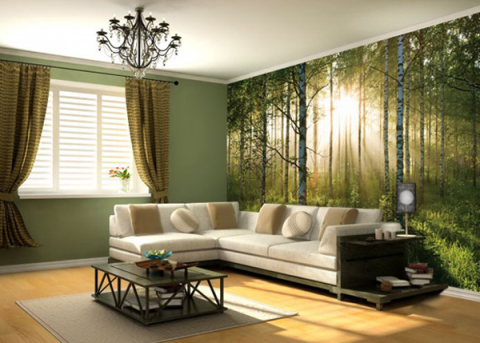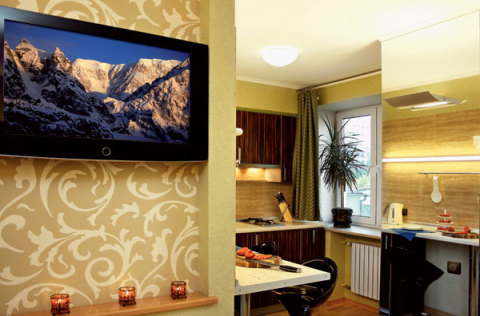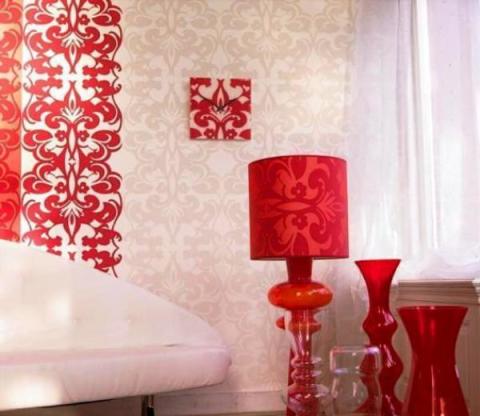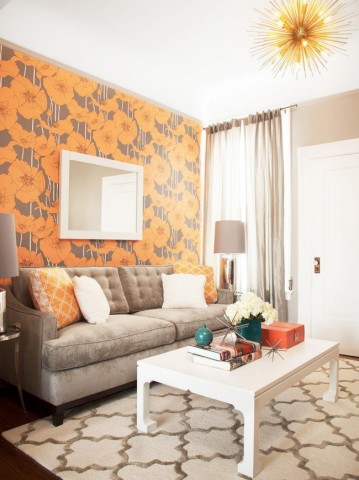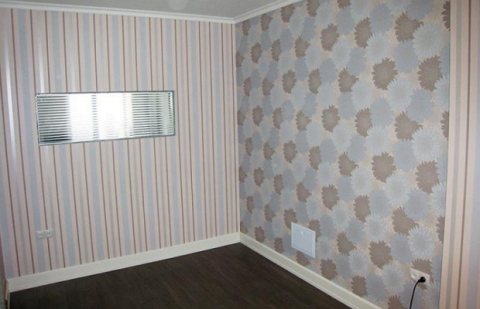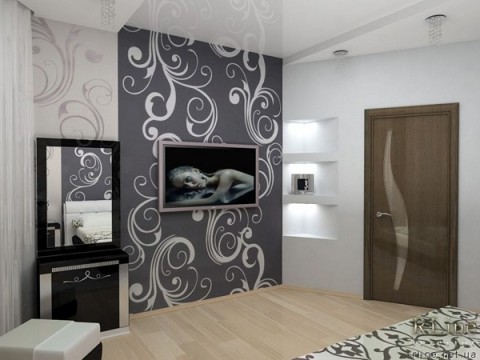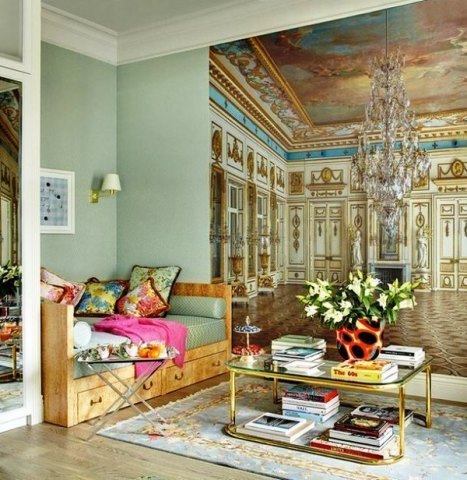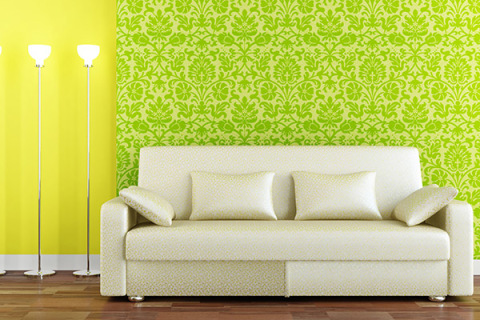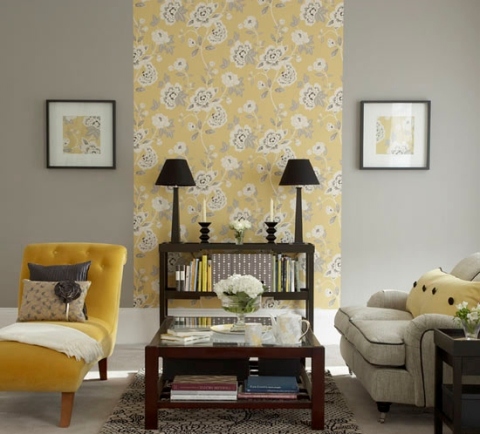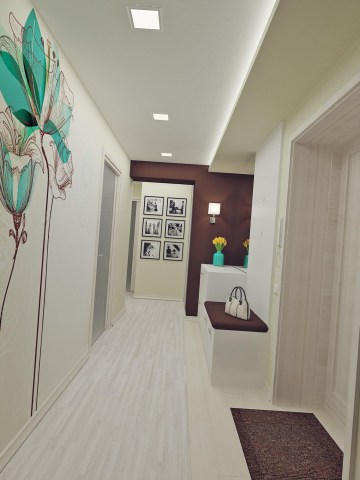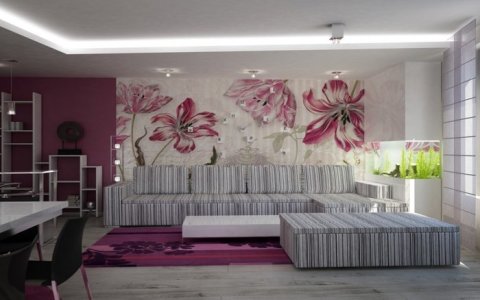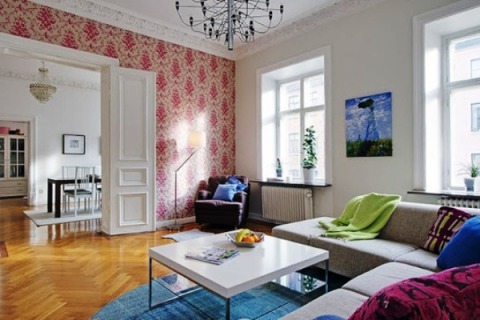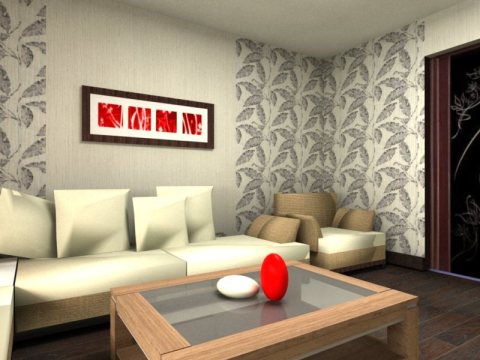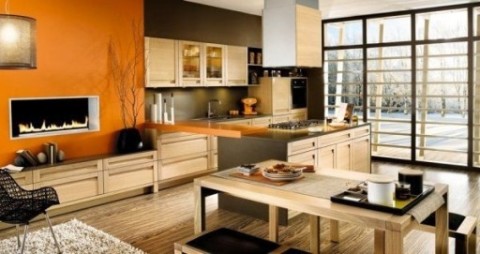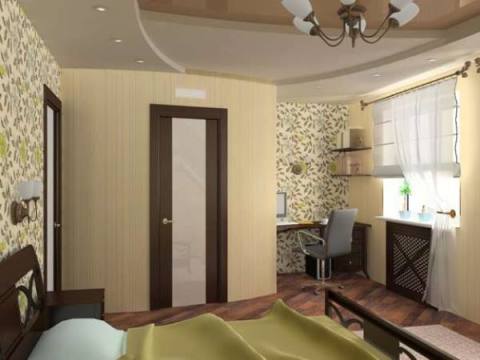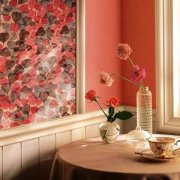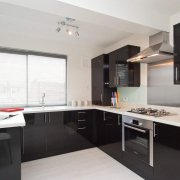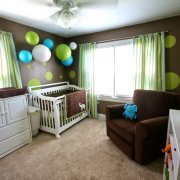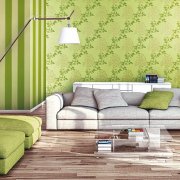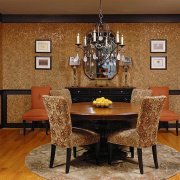Combined wallpaper for room design
To create an attractive room interior, wall decoration is of great importance. In this case, the combined wallpaper allows you to create an original design in any room. The article offers to get acquainted with the types of wallpaper and their combination on the walls in rooms for various purposes.
The content of the article
Types of Wallpaper
Wall decorative paintings differ in:
- To the material.
- The invoice.
- Durability.
- Resistance to wear.
- Longevity.
The main types of wallpaper are presented in the table:
| Benefits | disadvantages |
|
|
By structure, vinyl wallpaper consists of two layers: the top - vinyl, the bottom - non-woven or paper. In appearance they can be:
| |
|
|
The basis of textile wallpaper is non-woven or paper. Added: cotton, linen, jute or polyester, which determines the type of material. They may be:
| |
|
|
Non-woven wallpaper characterized by a very dense structure, in which polymer binder materials, textile fibers and long-fiber cellulose. | |
|
|
The basis liquid wallpaper - cellulose with additives that give the material different colors. | |
|
|
The wallpaper consists of a paper base, with the application of a metal layer of painted oxidized or aluminum foil with a pattern or embossing. | |
|
|
Wallpaper Combination Methods
The combination of materials - the usual design of wallpaper in the room. A limitless number of different options allows you to create perfect interiors, with incredible decorative effects. But when deciding to combine different types of wallpaper with your own hands, you need to get acquainted with the basic rules for performing these techniques.
The combination of wallpaper can be:
- Horizontal. For living rooms, this is not the best option - for many, it can cause the association of a hospital facility or entrance. However, with a serious and creative approach, horizontally arranged panels of wallpaper of various colors or textures look very cozy and warm, as seen in the photo.
Tip: When creating an interior in a retro style room, the lower part of the walls should be glued with paintings in a vertical strip, the top with materials with large ornaments, and the border should be made a spectacular border. In this case, the lower part becomes darker than the upper.
- Upright. The combination of vertical stripes of different textures or colors creates the effect of high ceilings. Thus, certain functional zones are highlighted in the room or lighting is adjusted - areas of the room that are not exposed to daylight are pasted with wallpaper of lighter tones.
- Patchwork. In this case, pieces of a simple or complex shape of the wallpaper are combined in a strict and concise panel, which depends on the desired effect in the room and the style of the interior.
- With wallpaper inserts. Usually, elements of large sizes are selected, which are necessarily decorated in frames from decorative paper tape. Inserts are used to highlight a specific area or can be an independent decorative detail - sticker mural.
The combination of different types of wallpaper
When combining wallpapers, they can be combined by:
- Color.
- Shades.
- Ornaments.
- To patterns.
- You can combine different textures of plain canvas.
There are several ways to combine wallpaper:
- Spectrum. This technique uses wallpaper of the same color, but in different shades. For instance:
- saturated coral and delicate peach;
- deep blue and pale blue;
- bright sand and discreet beige.
Each of the walls can be done in different colors, placing them in increasing order: from black to white, with several shades of gray or other colors.
- Balance. In this case, canvases with expressive ornaments or complex compositions of flowers are used, which are balanced by the wallpaper of the same color chosen by those present in the ornament.
- Duet. At the same time, wallpapers with various ornaments are combined. But this technique should be used very carefully. Harmonize among themselves and shades, and the type of pattern.
Tip: For clear patterns, you need to select wallpapers with abstract images. For example, from striped wallpaper and canvases with a small pattern of flowers or peas.
- Contrast. This option of combining wallpaper in different colors is great for youth-style rooms. Marital bedrooms and living rooms are best decorated in two colors: neutral and active. Visually enlarge the room will help dark murals in combination with light canvases (see.How to choose wallpaper: tips).
- Texture. When combining materials with different textures, they must be selected in one color, which will increase the effect. For instance: paper wallpaper Can be combined with vinyl. The latter on the walls will create a relief that will give the interior a highlight.
To better imagine all kinds of combinations of wallpapers when combining them, you should watch the video.
Wallpaper Combination Effects
When combining wallpapers, you can not only embody a beautiful design solution, but create a certain atmosphere in the room.
They can:
- Hide flaws. If the room is not too flat wall, the bright strip of wallpaper on the opposite wall distracts you. Various communications are also hidden, having a not very aesthetic appearance, or the view of guests is switched from the old furniture element to the original and stylish fragment of the decor of the room.
- Zoning space. Easiest to do combining wallpaper in the kitchen: design a zone for eating with a warm pattern of flowers, and highlight the work area with strict plain wallpaper. A room in a nursery for two toddlers can be distinguished by different wallpapers, clearly highlighting the territory for each of the children.
- Adjust the geometry of space. To do this, one of the walls stands out in the bright color of the paintings, so as to visually make a room of a small area larger. The long and narrow corridor will become visually more balanced if the side walls are pasted with light wallpaper and the end walls are darker.
- Create a decorative element on the wall. Select one of the walls with a saturated pattern or bright color.
- Create an accent. Using a piece of wallpaper of a different format, focus on a particular interior detail, which may be: a collection of souvenirs, a fireplace, a desktop.
Combining wallpaper in the living room
Warm colors help create a cozy and comfortable atmosphere in the living room. Dark colors-companions will visually compress the space, it is advisable to combine them only when decorating living rooms with a large area.
It is better to dilute the pastel on the walls with bright accents or with the right combination of two or three companion colors. Various combinations allow you to easily choose the type of finish that is most in harmony with the design of a particular living room.
When you design a living room, you can use some recommendations:
- Choose the same basic shade of wallpaper or ornament.
- The living room with contrasting colors of the partners looks bright and original.
- Often when decorating a living room, a layout of vinyl and paper wallpapers on the walls is used.
- An unusual design will turn out a combination of paper wallpaper and photo wallpaper.
- You can create a unique design by decorating the joints of the canvases with zigzag stripes or waves.
- In the design of living rooms, vertical combination is most often used, but the horizontal layout of the main color and horizontal stripes of contrasting shades also look very unusual.
- Horizontal combination divides the space into zones, and vertical combination of paintings in the interior of the living room creates a concise and somewhat futuristic design.
- The interior of the living room can be diluted with the original wall panel, consisting of small wallpaper flaps.
- The unusual design of the main surfaces can be made of wallpaper inserts that are trimmed with moldings or frames. This is how the baroque-style interior looks harmoniously.
- The use of inserts from photo wallpaper limited to moldings helps to emphasize the interior of the styles: modern, pop art, high-tech (seeMaking high-tech walls), country, provence and others.
The combination of wallpaper in the living room is a modern trend in the decoration of such premises.
Combining wallpaper in the kitchen
When you design a kitchen with combined wallpaper, there is a kind of instruction that offers:
- Do not purchase elite and cheap materials. It is best to combine wallpapers of the same quality and price, which differ in color and texture: glossy and matte, smooth and rough.
- Selecting canvases of the same thickness, this will not create problems when joining and selecting the edging.
- The combination of wallpaper should be in harmony with the style of the whole kitchen and fully reflect the specificity and functionality of this room.
- To create the most harmonious atmosphere in the kitchen, it is necessary to select wallpapers with overlapping design details: with different shades of the same color, with a single style of ornament.
- Bright panels of large width are recommended to be balanced with plain wallpaper or with a small discreet pattern.
- Floral ornament blends well with wood textures and patterns.
- Geometric motifs blend perfectly with abstractions.
- Active vibrant colors are best combined with muted neutral tones.
If there are two contrasting walls in the kitchen design, the alternation of vertical stripes on one of the adjacent walls will reduce the sharp edge, creating a smooth transition.
Combining wallpaper in the bedroom
In the bedroom, it is better to use natural wallpaper and choose the design of the room taking into account such recommendations:
- Do not combine more than three primary colors in the interior of the room.
- No more than three should be different patterns.
- To obtain greater expressiveness and expressiveness of the interior, you need to use large drawings.
- Dark colors make the room more cozy, secluded and intimate, due to the large absorption of the dark coating of light.
- Deep red color can only be used in bedrooms whose windows are located on the north side.
Tip: In such rooms, the walls should be decorated with warm shades, so as not to create physical and emotional coldness.
- Light wallpaper with small patterns will help to visually expand a small room.
- For combination, it is worth choosing materials from one collection and one manufacturer.
- Do not stand in a room where you need to relax, use catchy, expressive shades. If you want to add bright colors to the design of the bedroom, it is better to use accessories of such colors or to highlight the area at the head of the bed with contrasting canvases.
Ideal for the bedroom are such combinations of patterns:
- Polka dots / graphics with plain wallpaper.
- Rarely placed small dots / stripes with floral motifs.
- Paisley or cell with graphics.
- Ornament "ikat" with peas.
- Pastorals with stripes.
- Geometric patterns / photo wallpaper with plain wallpaper.
Tip: When designing a bedroom, you should choose wallpapers from one series. They are easier to combine, they look original and luxurious.
Combined wallpaper for the room and the design of the entire room are performed in the same style. They should create coziness and comfort in any room. Simple combinations can create a bright and original wall decoration, you just need to show imagination and determine the general theme of room design.
